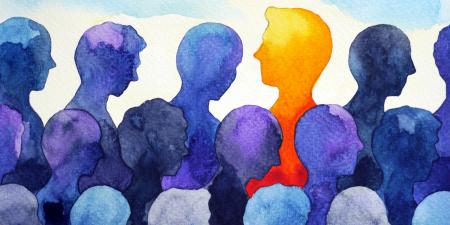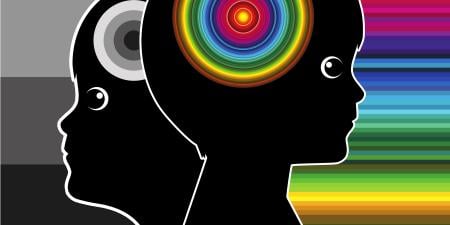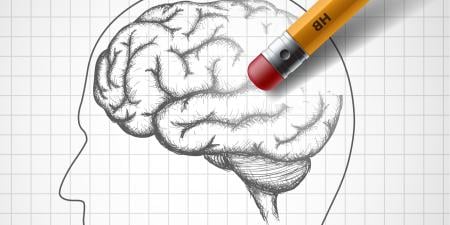Abstract
Art has the ability to entertain and educate about many vital aspects of the human experience. Recently, innovative endeavors are providing greater accessibility to theatrical productions for people with autism spectrum disorder (ASD), prompting ethical questions about how accommodations to provide access to art and culture should be made, and for whom. This article uses an attributional model of stigma to explain potential differences in knowledge, attitudes, and behavior toward people with mental illness. This social cognitive model also provides clues about how to spur social change through translational education, familiarization, and advocacy to permit greater access to art for people with disabilities.
I regard the theater as the greatest of all art forms, the most immediate way in which a human being can share with another the sense of what it is to be a human being.
Thornton Wilder [1]
Autism
Autism (currently referred to as autism spectrum disorder, or ASD, and used interchangeably here) is characterized by significant difficulty with reciprocal social communication; narrow, repetitive, or stereotyped thoughts and behavior; and atypical sensitivity to sensory stimuli [2]. A number of brain regions have been consistently implicated in the neuropathology of ASD, including those involved in emotion processing (e.g., amygdala, hippocampus), social cognition and theory of mind (e.g., medial prefrontal cortex, cingulate cortex, temporal parietal junction), face processing (e.g., fusiform network), and executive functioning [3-8]. The neuropsychological challenges impact many areas of an affected person’s life, impeding his or her ability to engage in many social, community, and cultural events.
The overall prevalence of ASD, based on data collected from the Autism and Developmental Disabilities Monitoring Network sites [9], rose approximately 223 percent between 2002 and 2010 and in 2012 was estimated to be 1 in 68 children eight years of age (1 in 42 boys, 1 in 189 girls) [10]. Approximately thirty-two percent of these children have co-occurring intellectual disability (IQ ≤ 70), 24.5 percent fall in the borderline range (IQ = 71-85), and 43.9 percent have cognitive abilities in the average or above-average range [10]. There is no doubt that autism is a significant public health concern with significant costs to the affected individuals, their families, and their communities [11]. In the United States, it is estimated that the lifetime cost per person with ASD is $1.4 million and, for those with co-occurring intellectual disability, $2.4 million [12]. In tandem with the significant increase in prevalence over the last several decades, there has been an evolution in how autism is understood, detected, and treated [13]. This once rare and mysterious condition is now broadly familiar to the public because of the dissemination of scientific information on and the familiarity of autism in the media and news.
Despite the increasing prevalence and public awareness of autism, many parents of children with autism still struggle with the fact that their children are unable to engage in cultural and recreational activities. In particular, the hyper- and hyposensitivity to a variety of visual, auditory, and tactile stimuli can limit the ability of a child with ASD to partake in social activities [14]. For example, children with ASD often have difficulty attending movies due to the crowds, flickering lights, darkness, and loud noise. According to a recent report, children with ASD participate less frequently in community-based events than those without ASD due to a combination of social and physical barriers and fewer supports [15]. Moreover, attendance at events is often limited by their affordability and accessibility. However, efforts by people outside of traditional therapeutic settings are providing new opportunities for people with ASD and their families to engage with an essential part of human culture: the arts. As described below, people with autism and their families are finding acceptance and access through participation in theater. In the process they are helping to remove the barrier of stigma and embracing their right to engage in and with the community.
The Value of Art and Theater for People with ASD
The arts are an essential element of education, just like reading, writing, and arithmetic…. Music, dance, painting, and theater are all keys that unlock profound human understanding and accomplishment.
William Bennett [16]
There is much to be gained from seeing, hearing, and experiencing art in a variety of forms. Many people with ASD excel in art and use it as a way to express themselves and share their unique perspective on the world [17, 18]. Some propose that the arts have the potential to nurture talent, reduce stigma, and provide a platform for others to see the “ability” in disability [19]. Art also provides an opportunity for persons with mental illness, such as schizophrenia, to build new identities and community [20]. Theatrical performances—dynamic, engaging, and narrative—have the rare ability to entertain and educate about many vital aspects of the human experience. Attending plays and musicals may provide an opportunity for people with autism and other disabilities to stimulate their imagination, observe social communication, and experience storytelling in an entertaining and live context [21]. Should not such potential benefits be shared by all, even those whom some would argue may not fully appreciate the depth or breadth of the narrative?
New and innovative endeavors by groups such as the Autism Theatre Initiative [22] and the Theatre Development Fund [23] have created “autism-friendly” performances of Broadway and off-Broadway shows to give people with autism unprecedented access to these forms of theater [21]. Accommodations such as brighter lighting, reduced sound, and preparatory story guides help make the experience less intense and stressful—and therefore more relaxed and pleasurable—for the audience. These initiatives have received rave reviews. After experiencing the supportive and slightly modified show, theatergoers with autism look forward to subsequent sensory-friendly productions with great anticipation, and some have transitioned to traditional theatrical performances [21].
Some theater-based programs use theatrical techniques as a form of treatment for children with ASD [24-26]. For example, studies we have conducted have shown that SENSE Theatre®, a theatrical intervention program in which youth with ASD learn a variety of acting techniques with peer actors who model communication and behavioral skills, contributes to significant changes in participants’ social competence, communication, cognition, and interaction skills [27-30]. Whether people with autism are onstage or in the audience, published and anecdotal reports [21, 28] suggest that the theater provides a distinctive setting where they may thrive. The supportive context, active role-playing, and dynamic learning environment of the theater foster the development of key social skills that children with autism most need to learn.
Challenges to Making Theater Accessible to People with ASD
Man is unique not because he does science, and he is unique not because he does art, but because science and art equally are expressions of his marvellous plasticity of mind.
Jacob Bronowski [31]
To what extent is society responsible for making art equally available to all? In particular, should theater be accessible to all people with disabilities, including those with autism? To what extent should accommodations be made and for whom? According to Article 30 of the United Nations Convention on the Rights of the Child, participation in the arts is a right, not a privilege [32]. It is the right of all children to engage in their communities and participate in cultural, artistic, and recreational activities in accessible formats. While access to arts is a right, many people have difficulty engaging in cultural and artistic events due to perceived barriers—namely, stigma. The vast majority (90 percent) of parents of children with ASD think that persons with autism are stigmatized, and stigma plays a significant role in predicting how difficult life is for the parents [33]. In addition to stigmatizing peer and adult attitudes, limitations of services (e.g., availability of support), systems (e.g., affordability), and policies (e.g., environmental arrangements) contribute to reduced access to community participation [15].
Unfortunately, stigmatization of people with mental illness is long-standing. The term stigma originates from the Greek practice of branding slaves who had escaped with a mark called a sigma [34]. Subsequently, the term was extended to refer to any mark for perceived conditions deviating from social norms [35]. According to Thornicroft and colleagues [36], stigma contains three primary elements: lack of knowledge (ignorance), negative attitudes (prejudice), and negative behavior (discrimination).
Advanced by Corrigan, attribution theory provides a compelling social cognitive framework for understanding stigma [37]. Attribution theory is a classic model that helps explain how and why people attribute meaning to everyday events. In this model, causal attributions are based on the perceived locus of control (e.g., internal or external source), stability of the cause (e.g., extent to which change is possible), and controllability (e.g., the amount of influence a person has over an event to bring about change) [38]. For example, if others believe a person’s behavior is (internally) caused and unchanged by interventions (stable) and that the person lacks motivation to change (limited control), then they might be less sympathetic to the person. It can also explain how the public selectively includes or excludes people from aspects of society, because the public may make attributions about the cause of the difference. Applied to mental health stigma, the model explains relationships between people’s knowledge of, and their emotional reactions (e.g., fear, pity) and behavioral responses (e.g., helping, punishing) to, persons with mental health conditions [37]. In contrast to physical stigmas, most mental-behavioral conditions are perceived as onset-controllable (having a preventable cause) and unstable or reversible, contributing to the negative perceptions that the diagnosed person is somehow responsible for their condition. Consequently, research has shown that mental-behavioral (e.g., drug abuse) stigmas evoke less sympathy and helping behavior than physically based (e.g., blindness, cancer) stigmas [39].
Therefore, one explanation for the perceived difference in access granted to people with ASD is the public judgments that are made about people with different disabilities. For example, survey respondents more frequently expressed fear and distrust of, and social distancing from, people with schizophrenia than people with bipolar disorder or autism [40]. Ostensibly, some view people with schizophrenia as being more to blame for their condition, less responsive to treatment, and more helpless. In another survey in which respondents were asked about mental disorders using positive and negative stereotypes, autism was associated with high intelligence and creativity, and schizophrenia was associated with danger [41].
The attribution model has far-reaching implications not only for explaining stigma but also for explaining how to bring about societal change by increasing knowledge of, and changing emotional reactions and behavioral responses to, persons with mental illness [37]. Familiarity with a condition like autism matters because knowledge of the disorder can decrease discriminatory behavior [42] and reduce social distancing. Moreover, survey respondents who were asked about individuals with a condition rather than simply about a disorder tended to be less negative and more compassionate [40]. These findings suggest that strategies that raise the visibility of individuals and not just disorders will be important for changing attitudes and behaviors. Efforts and programs that increase public awareness, education, and broader acceptance may alleviate the challenge of raising a child with autism [20]. These strategies can also be applied to other mental and physical disabilities. In this way, a translational approach that highlights similarities between disorders (e.g., between ASD and schizophrenia) rather than differences may be helpful in reducing social distancing. Since perceptions are inherently more negative for some disabilities, visibility alone will likely not suffice in garnering public acceptance of a given disorder.
Advocacy is another way to challenge the attributions the public makes about people with mental and physical disabilities. Caregivers of persons with autism have been extraordinarily resourceful, relentless, and creative in their advocating for the best interest of family members on the autism spectrum. These parental passions have contributed to the formation of several productive educational and funding organizations, including the National Alliance for Autism Research and Cure Autism Now, which merged to form Autism Speaks in 2005 [43]. Familial and professional caregivers of persons with disabilities and mental illness can embrace the power of advocacy and educate the public and media on mental health, which is a core mission of the National Alliance for Mental Illness [44]. In addition to public announcement campaigns and lobbying efforts, education on mental illness can be meaningfully conveyed through exposure, shared experiences, and artistic expression via attending theater. In this way, art can be seen as a form of advocacy, a way to experience other perspectives.
Conclusion
As we contemplate ethical considerations of accessibility of theater for people with ASD, perhaps the more important question is why is such access exceptional? Inclusion for people with disabilities in arts and culture is not simply a matter of access, but a right. The theater is providing a welcome and supportive context in which people with autism and their families are finding greater access and acceptance. It has the potential to unlock understanding of the human experience for children with autism as well as the larger community. Through translational education that allows people to view a mental illness such as autism as merely difference and not deviance, social change is possible. As children with autism gain greater access to theater, with opportunities for reciprocal social communication, the community gains greater awareness of autism, thereby reducing the barrier of stigma.
References
-
Thornton Wilder, the art of fiction no. 16 [transcript]. Paris Review. 1956;15. http://www.theparisreview.org/interviews/4887/the-art-of-fiction-no-16-thornton-wilder. Accessed October 27, 2016.
-
American Psychiatric Association. Diagnostic and Statistical Manual of Mental Disorders. 5th ed. Arlington, VA: American Psychiatric Publishing; 2013.
- Adolphs R, Sears L, Piven J. Abnormal processing of social information from faces in autism. J Cogn Neurosci. 2001;13(2):232-240.
- Baron-Cohen S, Ring HA, Wheelwright S, et al. Social intelligence in the normal and autistic brain: an fMRI study. Eur J Neurosci. 1999;11(6):1891-1898.
- Edmiston EK, Merkle K, Corbett BA. Neural and cortisol responses during play with human and computer partners in children with autism. Soc Cogn Affect Neurosci. 2015;10(8):1074-1083.
- Schultz RT, Gauthier I, Klin A, et al. Abnormal ventral temporal cortical activity during face discrimination among individuals with autism and Asperger syndrome. Arch Gen Psychiatry. 2000;57(4):331-340.
- Cascio CJ, Foss-Feig JH, Heacock J, et al. Affective neural response to restricted interests in autism spectrum disorders. J Child Psychol Psychiatry. 2014;55(2):162-171.
- Solomon M, Yoon JH, Ragland JD, et al. The development of the neural substrates of cognitive control in adolescents with autism spectrum disorders. Biol Psychiatry. 2014;76(5):412-421.
-
Centers for Disease Control and Prevention. Research: Autism and Developmental Disabilities Monitoring (ADDM) Network. http://www.cdc.gov/ncbddd/autism/research.html. Accessed October 31, 2016.
- Christensen DL, Baio J, Braun KV, et al. Prevalence and characteristics of autism spectrum disorder among children aged 8 years—Autism and Developmental Disabilities Monitoring Network, 11 sites, United States, 2012. MMWR Surveill Summ. 2016;65(3):1-23.
-
Horlin C, Falkmer M, Parsons R, Albrecht MA, Falkmer T. The cost of autism spectrum disorders. PLOS One. 2014;9(9):e106552. http://journals.plos.org/plosone/article?id=10.1371/journal.pone.0106552. Accessed October 25, 2016.
- Buescher AV, Cidav Z, Knapp M, Mandell DS. Costs of autism spectrum disorders in the United Kingdom and the United States. JAMA Pediatr. 2014;168(8):721-728.
-
Dawson G, Bernier R. A quarter century of progress on the early detection and treatment of autism spectrum disorder. Dev Psychopathol. 2013;25(4)(pt 2):1455-1472.
- Little LM, Ausderau K, Sideris J, Baranek GT. Activity participation and sensory features among children with autism spectrum disorders. J Autism Dev Disord. 2015;45(9):2981-2990.
-
Egilson ST, Jakobsdóttir G, Ólafsson K, Leósdóttir T. Community participation and environment of children with and without autism spectrum disorder: parent perspectives [published online ahead of print June 22, 2016]. Scand J Occup Ther. doi:10.1080/11038128.2016.1198419.
-
Bennett WJ. First Lessons: A Report on Elementary Education in America. Washington, DC: US Department of Education; 1986:35.
- Mullin J. Drawing autism: showcasing the artistic talents of people with autism. AMA J Ethics. 2015;17(4):359-361.
- Svoboda DJ, Hosseini K, Schneider N, Casanova E, Aitch K. Artwork by people with autism. AMA J Ethics. 2015;17(4):362-368.
- Lamb J. Creating change: using the arts to help stop the stigma of mental illness and foster social integration. J Holist Nurs. 2009;27(1):57-65.
- Howells V, Zelnik T. Making art: a qualitative study of personal and group transformation in a community arts studio. Psychiatr Rehabil J. 2009;32(3):215-222.
-
Viswanathan V. Making theater autism-friendly. Atlantic. April 6, 2015. Accessed September 13, 2016. http://www.theatlantic.com/health/archive/2015/04/making-theater-autism-friendly/388348/. Accessed October 31, 2016.
-
Theatre Development Fund. Autism Theatre Initiative: making theatre accessible to individuals with autism. https://www.tdf.org/nyc/40/Autism-Theatre-Initiative. Accessed September 13, 2016.
-
Theatre Development Fund website. https://www.tdf.org. Accessed September 13, 2016.
- Corbett BA, Gunther JR, Comins D, et al. Brief report: theatre as therapy for children with autism spectrum disorder. J Autism Dev Disord. 2011;41(4):505-511.
- Guli LA, Semrud-Clikeman M, Lerner MD, Britton N. Social Competence Intervention Program (SCIP): a pilot study of a creative drama program for youth with social difficulties. Arts Psychother. 2013;40(1):37-44.
- Lerner MD, Mikami AY, Levine K. Socio-dramatic affective-relational intervention for adolescents with asperger syndrome and high functioning autism: pilot study. Autism. 2011;15(1):21-42.
-
Corbett BA, Blain SD, Ioannou S, Balser M. Changes in anxiety following a randomized control trial of a theatre-based intervention for youth with autism spectrum disorder [published online ahead of print May 5, 2016]. Autism. doi:10.1177/1362361316643623.
- Corbett BA, Key AP, Qualls L, et al. Improvement in social competence using a randomized trial of a theatre intervention for children with autism spectrum disorder. J Autism Dev Disord. 2016;46(2):658-672.
-
Corbett BA, Qualls LR, Valencia B, Fecteau SM, Swain DM. Peer-mediated theatrical engagement for improving reciprocal social interaction in autism spectrum disorder. Front Pediatr. 2014;2:110. http://journal.frontiersin.org/article/10.3389/fped.2014.00110/full. Accessed October 31, 2016.
- Corbett BA, Swain DM, Coke C, et al. Improvement in social deficits in autism spectrum disorders using a theatre-based, peer-mediated intervention. Autism Res. 2014;7(1):4-16.
-
Bronowski J. The Ascent of Man. Boston, MA: Little, Brown; 1973:11.
-
United Nations. Convention on the Rights of Persons with Disabilities. http://www.un.org/disabilities/convention/conventionfull/shtml. Accessed September 13, 2016.
- Kinnear SH, Link BG, Ballan MS, Fischbach RL. Understanding the experience of stigma for parents of children with autism spectrum disorder and the role stigma plays in families’ lives. J Autism Dev Disord. 2016;46(3):942-953.
-
Funk CE. Therapy Hangs a Table. New York, NY: Harper & Row; 1950.
-
Jones EE, Farina A, Hastorf AH, Markus H, Miller DT, Scott RA. Social Stigma. San Francisco, CA: Freeman; 1984.
-
Thornicroft G, Rose D, Kassam A, Sartorius N. Stigma: ignorance, predjudice or discrimination? Brit J Psychiatry. 2007;190(3):192-193.
- Corrigan PW. Mental health stigma as social attribution: implications for research methods and attitude change. Clin Psychol Sci Pract. 2000;7(1):48-67.
- Weiner B. Attribution theory and attributional therapy: some theoretical observations and suggestions. Brit J Clin Psychol. 1988;27(pt 1):99-104.
- Weiner B, Perry RP, Magnusson J. An attributional analysis of reactions to stigmas. J Pers Soc Psychol. 1988;55(5):738-748.
-
Durand-Zaleski I, Scott J, Rouillon F, Leboyer M. A first national survey of knowledge, attitudes and behaviours towards schizophrenia, bipolar disorders and autism in France. BMC Psychiatry. 2012;12:128. http://bmcpsychiatry.biomedcentral.com/articles/10.1186/1471-244X-12-128. Accessed October 31, 2016
- Jensen CM, Martens CS, Nikolajsen ND, et al. What do the general population know, believe and feel about individuals with autism and schizophrenia: results from a comparative survey in Denmark. Autism. 2018;20(4):496-508.
- Corrigan P, Markowitz FE, Watson A, Rowan D, Kubiak MA. An attribution model of public discrimination towards persons with mental illness. J Health Soc Behav. 2003;44(2):162-179.
- Silverman C, Brosco JP. Understanding autism: parents and pediatricians in historical perspective. Arch Pediatr Adolesc Med. 2007;161(4):392-398.
-
Flynn LM. The stigma of mental illness. New Dir Ment Health Serv. 1987;34:53-60.



